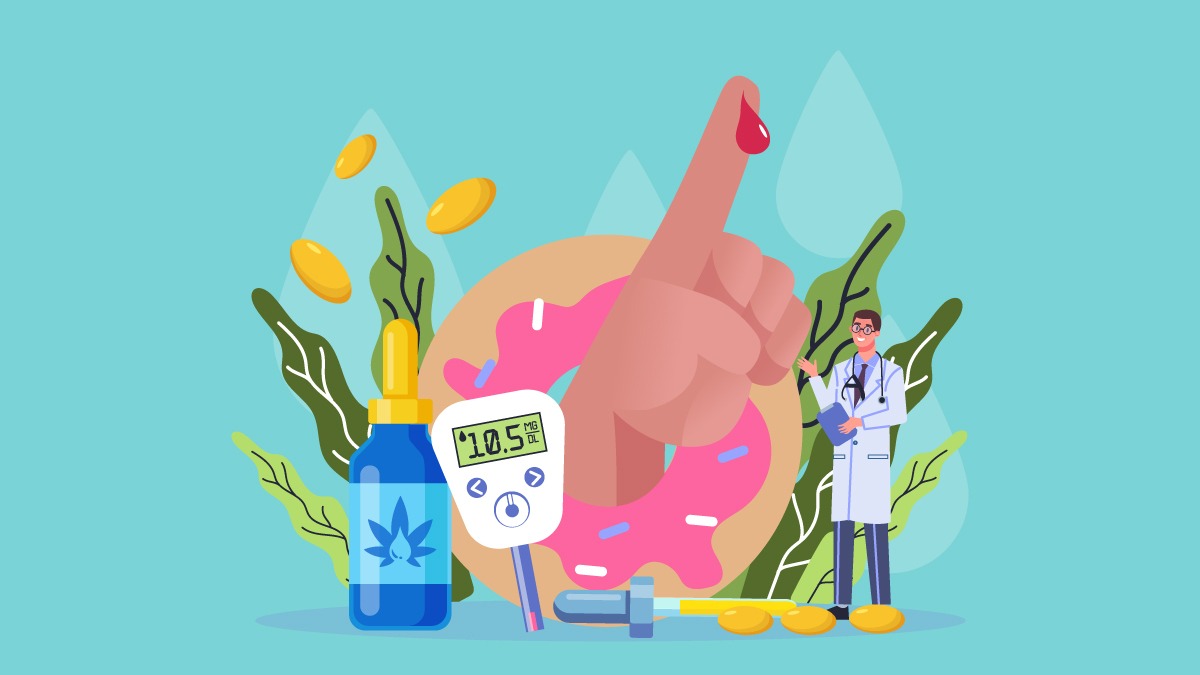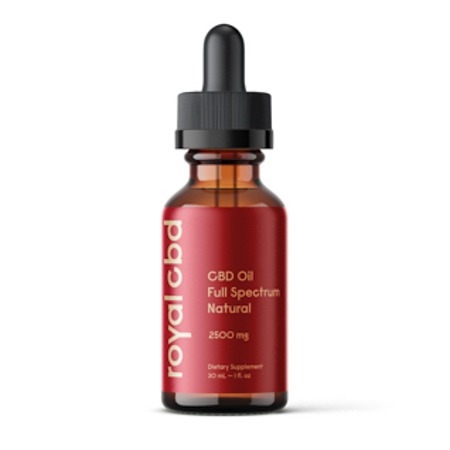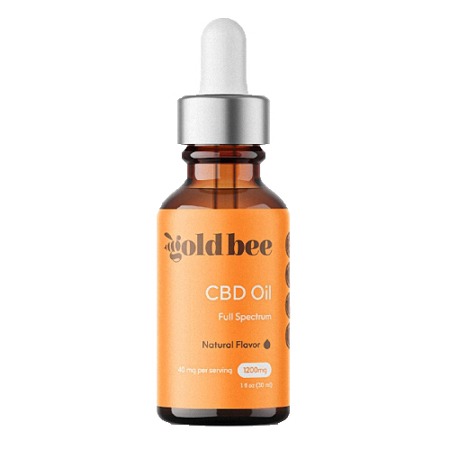CBD oil has become a popular option for people suffering from several diseases and medical conditions.
How popular is it? Cannabidiol (the complete name for CBD) was only legalized for sale in America in 2018. But by 2020, the industry had grown into a nearly $10 billion a year business, and forecasters predict it will double in size by 2025.
What’s most amazing about those numbers: so far, the only approval CBD has received from the federal government is to treat anxiety to relieving chronic pain. All of its other possible benefits have yet to be definitively proven; the sale and use of cannabidiol for those purposes are largely based on preliminary research, some of it done with animal subjects.
There’s one other basis: anecdotal reports and testimony from thousands of patients who’ve found that CBD is indeed able to treat their conditions or improve the symptoms successfully they’re suffering from.
One of the promising uses for CBD oil has turned out to be treating patients with diabetes. Initial studies show that cannabidiol is apparently able to reverse increases in markers like high glucose levels and insulin sensitivity. And those results are supported by the improvements in health that people with diabetes using cannabidiol have experienced.
When you’re ready to try CBD oil for diabetes, it’s important to buy a high-quality product because there’s a lot of cheap CBD out there which won’t deliver the results you want or need.
We’ve reviewed many CBD oils on the market, and these are the best.
Best CBD Oil for Diabetes – Top Brands Reviews for 2022
1. Royal CBD Oil
A high-quality product doesn’t require a well-known brand name, lots of marketing, or widespread distribution. It simply requires company ownership that cares deeply about its product, a commitment to using the best manufacturing processes, and careful quality control.
That’s why even though you may never have heard of Royal CBD, it produces the best CBD oil available. The founders’ resumes show experience in high-end cannabis manufacturing. The company shows devotion to the same principles in the production of their cannabidiol products. It produces in limited quantities to ensure the highest-possible CBD oil.
Royal sources its cannabidiol from organic, non-GMO hemp farmed on the West Coast, extracts the CBD with the most effective (and most expensive) supercritical CO2 process and uses high-end MCT carrier oil to create an outstanding full-spectrum oil. No corners are cut, so this is a relatively expensive product – but the extra price is worth it.
Royal CBD oil is available in four different potencies. The “beginner” level contains 250mg of cannabidiol per bottle, which equals 8.5 milligrams per milliliter of oil. On the high end, the 2500mg bottle provides 83.3mg/ml, which should be sufficient for even the serious pain that comes with some complications of diabetes. Four flavors are available, natural, mint, vanilla, and berry, with the latter three options flavored with natural essential oils.
Things We Liked:
- Organic US hemp, non-GMO
- Supercritical CO2 extraction and MCT carrier oil
- Full-spectrum oil with <0.3% THC for entourage effect
- Four well-chosen potency levels and flavors
Things We Didn’t Like:
- A little bit more expensive than other brands
2. Gold Bee CBD Oil
Since we’ve already described Royal CBD as producing its oil in “limited quantities,” we’re searching for a way to describe Gold Bee’s production. “Minimal quantities” might be the best choice since their products are often sold out on their own website. That’s not because Gold Bee makes super-expensive “boutique” products; they take so much time to perfect their product that they can’t always keep up with demand.
Their focus on quality shows in the end product. Like Royal, they don’t cut corners, using organic and non-GMO hemp (sourced from Colorado and California farmers), supercritical CO2 extraction, and MCT carrier oil for manufacturing their full-spectrum CBD oil. The quality is unmistakable.
The choices, however, are few. When you can find it, Gold Bee CBD oil comes in three flavors, natural, Kiwi-Honey, and Lychee-Honey (from natural essential oil flavoring). And there are just two potencies, with the highest (80mg/ml) perhaps not strong enough for many patients. We’re hopeful that they add a higher-strength option and boost production capacity (and maybe add some more flavors) since this oil is worth more attention than it receives.
Things We Liked:
- US organic hemp
- Full-spectrum oil
- Supercritical CO2 extraction
- All-natural
Things We Didn’t Like:
- Only sell online
- Not many flavors, only low-potency choices
3. CBDPure Hemp Oil
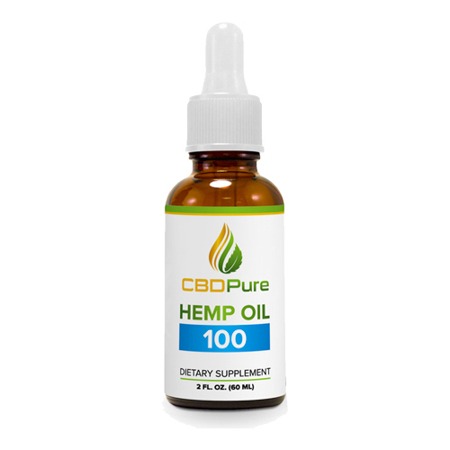
CBDPure’s top strength of 33mg/ml certainly won’t do you much good. It’s only manufactured in “natural” flavor, another drawback for those who don’t like the raw taste of hemp. However, that doesn’t mean this oil is a bad choice for those who are looking for lower-potency CBD oil.
CBDPure sources its cannabidiol from Washington State organic hemp extracts it with the standard CO2 method (not quite as desirable in terms of potency, but not terrible), and uses hemp seed oil as a carrier (not a bad choice). In essence, this is only slightly behind our first two choices when it comes to quality.
This hemp oil is easier to find and slightly less expensive than some of its competitors, making it a decent option for diabetes and other medical issues.
Things We Liked:
- Organic American hemp
- Full-spectrum oil, the full entourage effect
Things We Didn’t Like:
- Slightly less-effective extraction methods
- Slightly less-effective carrier oil
- No high-strength oils
- Only one flavor
Best CBD Oil for Diabetes: Buying Guide
There are fundamental differences between the two types of diabetes.
Type 1 diabetics usually develop the disease when they’re quite young (the “old name” for the disease was juvenile diabetes), and it’s a lifelong autoimmune problem. In short, inflammation leaves the pancreas unable to manufacture insulin, which the body needs to control blood sugar.
By contrast, type 2 diabetes isn’t caused by a lack of insulin. It’s due to either a shortage of insulin because of problems with the pancreas or the body’s inability to process the pancreas’ insulin properly. The term used to describe the second issue is “insulin resistance.” Type 2 diabetes can develop at any age, but it’s most likely to appear in adults later in life, particularly if the disease runs in their families.
It’s quite common for type 2 diabetics to have additional health challenges like high blood pressure, high cholesterol, and triglyceride levels – and, as you’d probably guess, obesity. None of those conditions are caused by diabetes; they’re risk factors for developing it. So if there were a way for people to reduce those risks, it would theoretically prevent cases of type 2 diabetes.
That’s more than theoretical, of course. Proper diet, exercise, smoking cessation, and generally healthy lifestyles can control those health risks and lower patients’ risk of contracting diabetes.
Add one more possibility to the list: CBD oil.
Does CBD Really Prevent Diabetes?

No one really knows yet. And no one knows if it can reverse the progress of the disease, either. Research is still in its infancy, so it’s impossible to conclude.
However, there are extremely encouraging preliminary study results, along with anecdotal evidence suggesting that CBD oil may effectively treat or even prevent diabetes.
The only study that specifically examined the use of cannabidiol for that purpose was done with rats. It showed that administering CBD drastically reduced the incidence of diabetes in non-obese rats from 86% to 30% by lowering blood sugar and cholesterol levels while increasing insulin production. That obviously doesn’t mean the same result would be seen in humans, but the significant decrease has naturally piqued the interest of medical researchers.
One reason that experts suspect that CBD could help with weight loss involves a short-lived anti-obesity drug, rimonabant. It was only available in Europe for several years before it was withdrawn from the market due to serious psychiatric side effects. However, it caused weight loss by interacting with the CB1 receptors of the body’s endocannabinoid system (ECS) – some of the same receptors that CBD interacts with.
There’s a long way to go before we have solid answers regarding cannabidiol’s ability to prevent or reverse diabetes since its interactions with CB1 (and CB2) receptors are still being studied (1). But when it comes to reducing the risk factors that cause many people to develop diabetes and treating the often serious complications of the disease, there’s much more evidence.
CBD and Diabetes Risk Factors
We’ve mentioned several illnesses and conditions that make people more likely to develop type 1 and type 2 diabetes. And research into cannabidiol’s ability to treat those problems is promising.
Inflammation
Inflammation is the main culprit to blame for type 1 diabetics’ inability to produce insulin. It’s also believed to play a major role in type 2 diabetes; insulin resistance can lead to inflammation, and inflammation can cause additional insulin resistance in a vicious circle (2).
As it turns out, studies have shown that CBD appears to be effective at reducing pancreatic inflammation in diabetic animals (through interaction with the CB2 receptors in the ECS) and that it can be an effective treatment for patients with inflammatory diseases like rheumatoid arthritis (3). The same basic conclusion was reached in a study involving rats who showed signs of inflammation caused by high glucose levels.
Obesity and Insulin Resistance
Insulin resistance is one of the two reasons patients may develop type 2 diabetes, and obesity is a major risk factor for the emergence of the disease. A comprehensive research survey has concluded that CBD’s anti-inflammatory and antioxidant properties may effectively reduce insulin resistance and even combat obesity (4).
A related property of CBD may be the ability to turn stored “white fat,” which is difficult to burn, into more easily burned “brown fat.” That possibility has major implications for the use of cannabidiol for weight loss, which would, in turn, have major implications for the prevention of type 2 diabetes.
Blood Pressure
Another major risk factor for the development of diabetes is high blood pressure. And if you’ve been following along, you’ve probably guessed what substance has been shown to reduce elevated blood pressure: CBD.
Just one dose of cannabidiol given to human test subjects was able to significantly lower their resting blood pressure, as well as moderate increases in blood pressure due to stress. That’s supported by another research summary showing that CBD is a promising treatment for a wide range of cardiovascular issues.
The same applies to CBD’s apparent ability to lower cholesterol and triglyceride levels, which would again reduce important risk factors for the development of diabetes.
Complications of Diabetes
Diabetes is such an insidious disease because its sufferers are at greater likelihood of developing severe, sometimes life-threatening complications. Among the most common issues are neuropathy (an often debilitating nerve pain), retinopathy (which can cause blindness), cardiovascular complications, and renal failure. Research has shown that all are controlled, at least to some degree, by the ECS receptors – and that CBD has shown promise to ease all of those symptoms (5).
CBD Oil vs. Other Forms of CBD
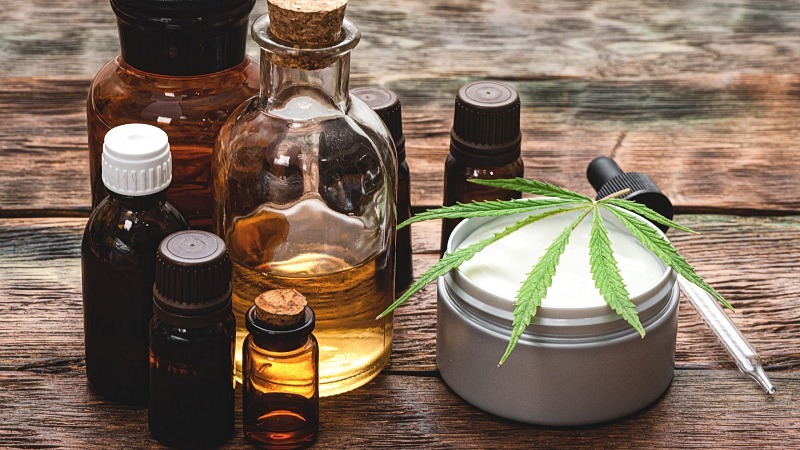
You can consume CBD in nearly any way imaginable. You can eat it (in edibles like cookies or as cannabidiol infused gummies or drinks), you can take it in capsules, you can vape it, and you can rub CBD cream into your muscles. Or you can do what’s easiest: place a few drops of CBD oil under your tongue in what’s known as sublingual administration.
Edibles and capsules will work, but many cannabidiol will be lost during the time-consuming digestion process. Topical administration doesn’t help most patients since CBD applied to the skin cannot make it past the epidermis to reach the rest of the body.
Read our in-depth review of the best CBD capsules here.
The most effective ways to use CBD are sublingually or by vaping because very little cannabidiol is lost, and the process works very quickly. However, to vape CBD, you’ll need equipment, expertise, and, most importantly, a willingness to inhale vapor deep into your lungs. That’s why using CBD oil is most people’s preferred method.
The oil doesn’t taste great, but most vendors offer flavored options to make CBD oil more palatable. The only other issue to deal with: how much oil do you use?
Some manufacturers make it easier by including dosage instructions. If they don’t, here’s how it works.
The recommended starting dose is 1-2 milligrams of cannabidiol for every ten pounds of your weight. That math is relatively easy to do. But oil is a liquid, and liquid isn’t measured in milligrams. It’s measured in milliliters. If you want to take 20mg of CBD, for example, you need to figure out how many milliliters of oil that dose requires.
Here’s how to do it. Ignore the big number like “1000mg” on the front of the bottle because it tells you how much CBD is in the entire container. Instead, look for the potency number that tells you how much CBD is in each milliliter of oil; it will be something like “20mg/ml,” which means a milliliter will contain 20mg of cannabidiol.
It’s easy from there. Want to take 20mg? In our example, that would be one milliliter of oil. If your oil’s potency is 40mg/ml, then you’d need half a milliliter of oil to take 20mg of CBD.
Not oil is created equal, though.
Choosing the Best CBD Oil for Diabetes
There’s often a good reason to choose name-brand products instead of generics. In many cases, generic products don’t contain the same effective ingredients as the branded ones. In other cases, generic manufacturers cut corners so they can sell their products at lower prices.
CBD’s in a different category than prescription drugs since it has only been legal for a few years, CBD products don’t require federal approval, and there’s no established “brand name.” But when you’re putting something into your body for medicinal purposes, it only makes sense to look for the highest-quality product you can find.
CBD oil means making sure the manufacturer has taken every possible step to create a high-quality product. These are the specifics to look for.
- Full-spectrum oil: Any CBD labeled “full-spectrum” will provide the greatest medical benefit because of what’s called the “entourage effect.” In brief, cannabidiol works best when all of the other important parts of a hemp plant (cannabinoids, terpenes, and flavonoids) are also present. Full-spectrum oil contains all of those components, so it works best.
When an oil contains only CBD and nothing else from the plant, it’s called “CBD isolate” and doesn’t work quite as well. The only reason to buy it is that it theoretically ensures you won’t test positive for the tiny amount of THC (<0.3%) that’s present in hemp. In truth, it’s doubtful that you’ll test positive when using full-spectrum oil, either.
- Sourced from organic, non-GMO hemp: The benefits of organically-grown products without GMOs are obvious, particularly if you’re concerned with your health – but the use of organic hemp also shows that a manufacturer is concerned with creating the highest-quality product possible. Look for oil made from American hemp since U.S. growers have to adhere to strict farming regulations.
- Supercritical CO2 extraction: Another sign that a producer cares about their product and their consumers is that they use the most effective method to extract CBD from hemp, even if it’s the most expensive method. Supercritical CO2 fits that description; it costs more, but it does the best job preserving cannabidiol’s potency.
Your CBD oil will still be safe and relatively effective if the manufacturer used (in descending order of preference) standard CO2 extraction, cold-press extraction, steam distillation, or extraction with natural solvents. It just won’t be as good. (By contrast, super-cheap extraction with hydrocarbons may not create a safe CBD product.)
- No unnecessary or artificial additives: CBD oil must contain a carrier oil to transport and distribute the cannabidiol. In theory, those are the only two ingredients you’ll find in high-quality CBD oil. In practice, a flavoring agent may be needed to cover the raw taste of the product, but it should always be a natural essential oil and not an artificial flavoring.
- Certificate of Analysis (COA): A reputable producer will provide a COA with every CBD product sold. It shows the results of independent third-party testing and allows you to see exactly what’s in your CBD oil. There should be less than 0.3% THC, along with the promised amount of cannabidiol. It will also show you whether the oil contains the other hemp components that make it full-spectrum and whether it contains any hazardous chemicals or substances. If there’s no COA provided, that should be a red flag in itself.

